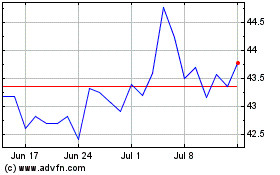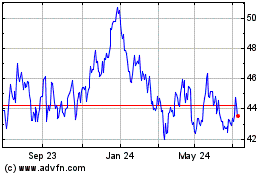RIO DE JANEIRO—Nearly 10 months after one of the biggest
disasters in the history of mining, the companies responsible for
the failure of a massive tailings dam in Brazil presented a
long-awaited report Monday on the causes of the incident.
But it added little information to what Brazilian police and
prosecutors already had gathered, and it presented no guidance on
how to prevent future accidents.
The Fundã o dam failure at mining giants Vale SA's and BHP
Billiton Ltd.'s Samarco joint-venture in Brazil is believed to have
been the largest such accident.
Its Nov. 5Â collapse released enough mine waste to fill the
Dallas Cowboys' AT&T Stadium at least 11 times. The waste
destroyed villages and killed 19 people as it rushed down one of
southeast Brazil's main river systems, polluting more than 400
miles of waterways along the way.
"My commitment is to learn every lesson we can from what
happened here," BHP Billiton Chief Executive Andrew Mackenzie said
Nov. 16. "We will be entirely open with the findings of this report
to hope that regulators and companies around the world benefit from
that learning, so that something like this never happens
again."
The 88-page report released Monday, however, explained little
more than the mechanics of the collapse, which Brazilian police
outlined in June.
Fundã o, an earthen dam, had been experiencing drainage problems
since at least 2009. A change to the dam's design in 2012 worsened
its drainage and left a key section of the dam's face resting on
top of unstable, silt-like mine waste known as "slimes," said the
report's lead author, renowned Canadian mining engineer Norbert
Morgenstern.
A series of very small earthquakes on Nov. 5 likely caused the
entire structure to turn to mush, a geotechnical phenomenon called
"liquefaction flowslide," Dr. Morgenstern said in a presentation on
the report's findings.
Left unsaid were what Brazilian authorities and many independent
experts have described as serious flaws in Samarco's risk
management and decision-making that led the company to continue
mining—and depositing waste into Fundã o—despite clear signs of
structural instability in the years before the disaster.
During an hour-long press conference, Dr. Morgenstern declined
to answer questions about what could have been done during Fundã
o's design, construction and operation to prevent it from
collapsing.
Reporters weren't allowed to direct questions to Vale CEO Murilo
Ferreira, Samarco CEO Roberto Carvalho or BHP Billiton Chief
Commercial Officer Dean Dalla Valle, who made brief opening and
closing statements but otherwise sat silently in the room while Dr.
Morgenstern presented the report.
Industry critics seized upon the report as evidence that mining
companies are trying to save their own necks rather than prevent
future disasters.
Lindsay Newland Bowker, an environmental risk manager in Maine
who studies accidents at mining dams, called it "a shameful
obfuscation."
"The narrow, contractually defined focus on 'proximate cause of
failure only,' masks, avoids and obfuscates all questions of
material relevance to a more comprehensive understanding," Ms.
Bowker said.
"This could just stand in history as a big PR play on the part
of Samarco, BHP and Vale, but it really depends on what the
prosecutor does next," she added.
A BHP Billiton spokesman described the report as "another step
in the process of finding out what happened."
"You need a proper technical understanding of what happened to
draw effective lessons for what must change," the spokesman said.
"This report provides the kind of detailed technical analysis the
industry needs to improve dam management."
A Vale spokeswoman declined to comment.
Brazilian federal prosecutors filed a civil case against Vale,
BHP Billiton and Samarco in May calling for 155 billion reais ($48
billion) in damages, comparing the fallout from Fundã o's collapse
to that of BP's Deepwater Horizon oil spill in 2010 in the Gulf of
Mexico.
The prosecutors also are working on separate criminal
investigations into the deaths and environmental damages caused by
the incident.
The fact that the report was commissioned by the mining
companies, and the legal liabilities they now face, likely led its
authors to stop short of making recommendations for how to make
tailings dams safer in the future.
That's not always the case, however. A report published last
year on the 2014 failure of Imperial Metals Corp.'s Mount Polley
tailings dam in Canada included a "Where do we go from here?"
section that included a series of recommendations for regulators,
engineers and mining companies.
Parts of Dr. Morgenstern's presentation appeared to contradict
earlier statements by Samarco, which previously characterized Fundã
o's collapse as completely unforeseeable and possibly caused by the
earthquakes.
A series of cracks in the dam's face, observed in August 2014,
"were indicative of instability," Dr. Morgenstern said, noting that
Samarco tried to reinforce Fundã o afterward. Some engineers say
Samarco should have stopped depositing waste into Fundã o as soon
as it detected the cracks, particularly considering the presence of
communities and drinking-water supplies downstream of the dam.
Samarco also did not have instruments in place that could have
detected slow-building deformities in the dam's shape that would
otherwise have been invisible to the naked eye, Dr. Morgenstern
said.
The earthquake, meanwhile, "was really quite small" and may only
have "accelerated" the dam's collapse, he said. "The failure
process without the earthquake was well advanced."
Write to Paul Kiernan at paul.kiernan@wsj.com
(END) Dow Jones Newswires
August 29, 2016 20:55 ET (00:55 GMT)
Copyright (c) 2016 Dow Jones & Company, Inc.
BHP (ASX:BHP)
Historical Stock Chart
From Mar 2024 to Apr 2024

BHP (ASX:BHP)
Historical Stock Chart
From Apr 2023 to Apr 2024
